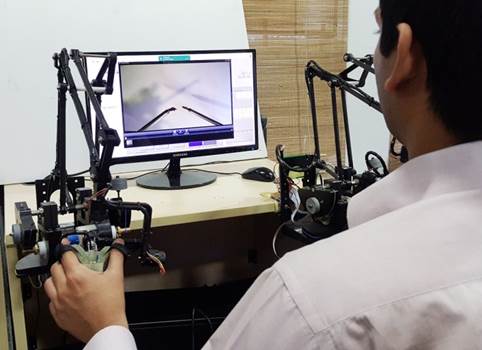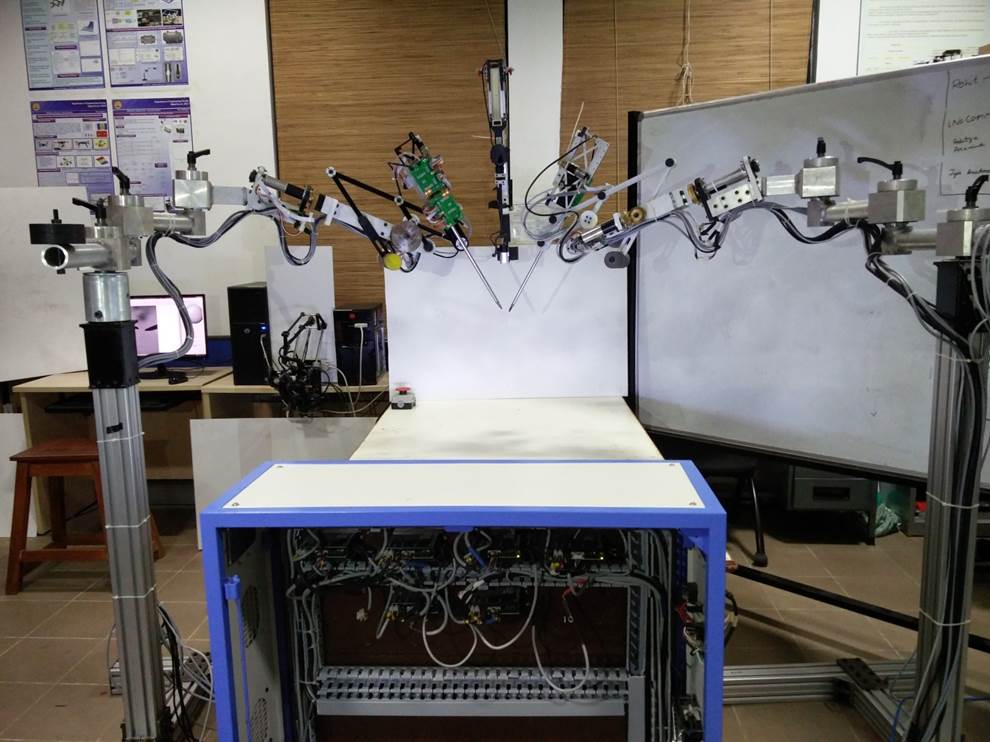Tele-operated robotic surgical system offers a paradigm shift in the way minimally invasive surgeries are carried out.
Advantages of tele-operation for surgery include improved precision, scaling of movement, compensation for hand tremor, and intuitive movement of surgical tools compared to laparoscopic surgery.
My research focuses on design and analysis of a tele-operated surgical robot for improved performance and safety.
Many of the conventional mechanisms of surgical robot are replaced by compliant mechanisms for improved surgical performance.
Some of the merits of utilizing compliant mechanisms for surgical robotics include mitigating biofouling of surgical tool with a single use flexure based tool tip,
inherent force limitation ability of flexures and capability to combine complex structures into a monolithic design.
I built the complete tele-robotic setup as part of my Ph.D. research. The three important modules of the surgical robot are master robot console, slave manipulators and a central controller.
There are two master arms with 7 degrees-of-freedom. Two slave arms and the surgical tool together have 7 degrees-of-freedom each.
The surgical tool alone has 4 degrees-of-freedom with wrist degree-of-freedom decoupled which makes the control strategy easier.
Journal publications
- Karthik Chandrasekaran and Asokan Thondiyath,
“Design of a 2 DOF compliant tool tip for a handheld powered surgical tool,”
ASME Journal of Medical Devices,
vol. 11, no. 1, p. 014502, March 2017,
doi: 10.1115/1.4034879.
Patents
- Karthik Chandrasekaran, Suraj Parameswaran and Asokan Thondiyath,
"A master slave tele-operated surgical robotic system for robotic surgery training",
Indian Patent Application No. 201741041857, 2017
- Karthik Chandrasekaran and Asokan Thondiyath,
"A magnetically coupled disposable compliant tooltip for robotic surgery for a design of a single use magnetically coupled surgical tool tip,"
Indian Patent Application No. E-2/3960/2017/CHE, 2017
-
Karthik Chandrasekaran and Asokan Thondiyath,
"Design of a 6 DOF Master Manipulator arm with enhanced gravity compensation and compliant grasping for robotic surgery,"
Indian Patent Application No. 6200/CHE/2015, 2015
-
Karthik Chandrasekaran and Asokan Thondiyath,
"A minimally invasive surgical tool for robotic surgery with disengaged degrees of freedom,"
Indian Patent Application No. 5620/CHE/2014, 2014
Conference publications
- Karthik Chandrasekaran, Adarsh Somayaji and Asokan Thondiyath,
“Realization of a Statically Balanced Compliant Planar Remote Center of Motion Mechanism for Robotic Surgery,”
in Proceedings of the 2018 Design of Medical Devices Conference,
Minneapolis, Minnesota, USA, April 9--12, 2018,
doi: 10.1115/DMD2018-6911.
- Karthik Chandrasekaran, Akhil Sathuluri and Asokan Thondiyath,
“MagNex- Expendable robotic surgical tool tip,”
in IEEE International Conference on Robotics and Automation (ICRA),
Singapore, May 2017, pp. 4221--4226,
doi: 10.1109/ICRA.2017.7989486.
- Karthik Chandrasekaran, Sakthivel Sivaraman and Asokan Thondiyath,
“Static Balancing and Inertia Compensation of a Master Manipulator for Tele-operated Surgical Robot Application,”
in Proceedings of the 2015 Conference on Advances In Robotics (AIR '15), Goa, India, July 02-04, 2015,
doi: 10.1145/2783449.2783463.
- Suraj Parameswaran, Karthik Chandrasekaran, Sourav Chandra and Asokan Thondiyath,
“Optimisation of an Active Remote Centre of Motion Mechanism for Minimal Extracorporeal Workspace for Robotic Surgery,”
in Proceedings of Conference on Advances In Robotics (AIR '13), Pune, India, July 04-06, 2013,
doi: 10.1145/2506095.2506106.
Faculty in-charge: Prof. Asokan Thondiyath
Students: Dr. Sourav Chandra, Mr. Karthik Chandrasekaran, Mr. Suraj Parameswaran, Mr. Vignesh Manoharan, Mr. Arjun Gupta, Mr. Ranjith Nayar, Mr. Srikar Annamraju



